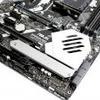Introduction
ASUS PRIME X570 Pro motherboard
It has been long overdue for us to review but we wanted to wait on AGESA 1.0.0.3 ABBA firmware before we'd continue, we finally had some time to peek at the PRIME X570 Pro series of motherboards for Ryzen 3000. AMD prepped the X570 chipset offering a more refined experience for your Ryzen Generation 3 processor. The board offers PCIe Gen 4.0 and has distinctive looks in its white design. This X570 motherboard is residing in the mainstream to high-end motherboard spectrum for the 3rd generation AMD Ryzen processors. With this release, you will spot a breathtaking motherboard loaded with features, DDR4 A-XMP functions, and PCIe 4.0 PCI slots and multiple PCIe 4.0 connected M.2. slots, with a massive heatsink as well. Other then that, the features are all very basic as there is no AX WIFI or Multi-GigE to be found on this board.
AMD has been going strong over the past year, rattling all the cages with an Intel logo on them. From top to bottom they have been able to compete with Intel. With Zen2 (codename 'Matisse') AMD is introducing a new line of processors starting at hexacore processors in the entry-level to mainstream segment (yeah, you read that right), eight and twelve cores for the mainstream to high-end, and up to 16-core Ryzen processors for the enthusiast level. It is batpoop crazy when you think about what AMD has accomplished in, what has it been, two years time? Sure, the initial ZEN Ryzen processors had a bit of a rocky launch with the inter-core latency discussion, 1080p gaming performance as well as memory support. But the tide turned with each month that passed, and over time more and more people would actually consider an AMD processor-based PC for their next purchase. That shift in the paradigm is big when you think about Intel's monopolized position in the desktop processor market. When AMD launched the 12nm update of Zen, called Zen+, the memory compatibility issues were mostly all gone, of course, and with the launch of Ryzen 3000, the 3rd generation Ryzen products, AMD is about to rattle the cages once again with a massively strong and competitive processor lineup. A topic of discussion has been chipset compatibility. Basically, in short, if you have a Series 300 or 400 chipsets AMD motherboard, you should seek a BIOS/firmware update from your motherboard's manufacturer. Ryzen 3000 processors will (read: should) work fine, with one distinction, you have reverted back to PCIe Gen 3.0, and that also goes for the x4 PCIe based interlink between the CPU and chipset. When we reverse the situation (use a Ryzen Series 1000 or 2000 on X570) we see a similar condition, most of the older Ryzen processors will work fine on X570, just not with PCIe 4.0 and dandy features like optional AX Wi-fi 6
So if you go with a proper processor, you'll like want a proper motherboard loaded with the latest and greatest. The PRIME X570 Pro is based on the new X570 chipset and thus its feature set. This socket AM4 motherboard offers extensive DDR4 memory support (as well as all other modern usual suspects like USB 3.2 gen 2, NVMe protocol 1.3 based M.2 support over PCI-Express Gen 4.0 and of course generic PCI-Express Gen 4.0 mechanical slots. This ATX Form Factor; 30.5cm x 24.4cm model, in particular, has PCIe slots with reinforcements to withstand the weight of high-end cards. The SupremeFX 8-Channel audio features a Realtek 1220 codec that improves input quality for streamers with an industry-leading 113-dB SNR. The motherboard is a very feature-rich product that will look terrific in any DIY PC build. The dark styled PCB comes with shielding and very subtle light accents. Features wise you may expect triple x16 PCI-Express slots (16x/8x/4x), an 8-channel audio solution, the usual quality components and USB 3.2. The board supports SLI and CrossFireX configs split between its main PCI Express x16 slots. The PCIe 4.0 and DDR4 slots have been reinforced to withstand the weight of high-end cards. Combine this motherboard with the Ryzen 3000 series six up-to sixteen-core processors and you'll be pleasantly surprised as to what it offers. Let’s start up the review, shall we?


